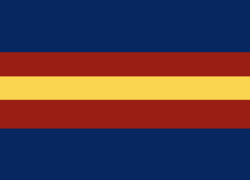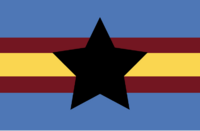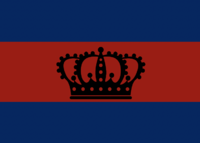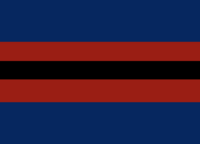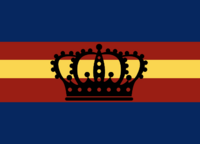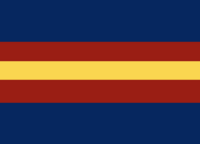Migaza
Republic of Migaza | |
|---|---|
|
Flag | |
Anthem: '' | |
| Capital | Nelphia |
| Religion | Muhadism (state religion as of |
| Demonym(s) | Migazan |
| Government | Republic |
| Maurice Travers (until 2015) | |
The Republic of Migaza, unofficially, Migaza was a large nation with a vast, complex history. Originally created as a peaceful territory dividing the great empires of Kathmantu and Varanasia, the region became an overseas territory of Elkifjor and its predecessor The Krystallic Empire. Migaza was a massive melting pot of ethnic groups, nationalities, and religions; a place of internal and extern strife, prosperity, and intellectual exploration. Migaza entered into the Great War at its beginning and the nation collapsed in 2015 following the GW's nuclear holocaust.
Contents
- 1 History of Migaza
- 1.1 Foundation of Independent Migaza (1043-1113)
- 1.2 The Colony of Migaza (1113-1212)
- 1.3 The Krystallic Colony of Migaza (1212-1415)
- 1.3.1 Rise of the Prosperity Syndicate
- 1.3.2 Death of Emperor Maurice Ostrovsky
- 1.3.3 Migaza Under Reign of Elise Ostrovsky
- 1.3.4 Migaza Under Reign of Nathaniel Ostrov
- 1.3.5 Migaza Under Reign of Zachariah Ostrov
- 1.3.6 Migaza Under Reign of Eric Ostrovia
- 1.3.7 Return of Emperor Zachariah Ostrovia
- 1.3.8 Migaza Under Reign of Katya Astoria
- 1.4 The Liberated State of Migaza (1415-1601)
- 1.5 The United Kingdom of Migaza (1601-1683)
- 1.6 The Unified Stratocracy of Migaza (1683-1786)
- 1.7 The Constitutional Monarchy of Migaza (1786-1865)
- 1.8 The Republic of Migaza (1865-2016)
History of Migaza
Foundation of Independent Migaza (1043-1113)
Flag of Independent Migaza | |
|---|---|
|
Flag |
The warring tribes of Kathmantu and Varanasia agreed to finally settle their scores by setting aside from land between them. They called this land Migaza, and it became a refuge for smaller, unrecognized and unwanted tribes as Independent Migaza in 1043. Independent Migaza was filled with mostly nomadic tribes with a loose set of guidelines for interaction, which was limited due to the vastness of its territory. The warring tribes of Kathmantu and Varanasia agreed to finally settle their scores by setting aside from land between them. They called this land Migaza, and it became a refuge for smaller, unrecognized and unwanted tribes as Independent Migaza in 1043. Independent Migaza was filled with mostly nomadic tribes with a loose set of guidelines for interaction, which was limited due to the vastness of its territory. The warring tribes of Kathmantu and Varanasia agreed to finally settle their scores by setting aside from land between them. They called this land Migaza, and it became a refuge for smaller, unrecognized and unwanted tribes as Independent Migaza in 1043. Independent Migaza was filled with mostly nomadic tribes with a loose set of guidelines for interaction, which was limited due to the vastness of its territory.
The Colony of Migaza (1113-1212)
Flag of the Colony of Migaza | |
|---|---|
|
Flag |
In 1102, Rafael Polonius sailed across "the Big Sea" from Elkifjor to Migaza, he disrupted the way of life for the natives. They resented his presence, and the leaders of Kathmantu and Varanasia decided to ensure the man from Elkifjor was silenced. When Polonius felt tensions were rising, that he was no longer welcome, he sent for additional troops from Elkifjor. They sent four ships worth of supplies and troops. The Migazans saw this as an attack, and began to fight the incoming troops. The troops of course, with their more developed technology, destroyed the tribesman who were attacking them. They leveled the port city and claimed it as the first colony for Elkifjor. The Migazan tribal leaders went to Kathmantu and Varanasia for support, but the two powers could not come to a compromise and pulled their support from Migaza. Within five years, the tribes had been decreased severely, their cities and towns were taken over by Elkifojoran colonists, and modernized. The Migazan leaders finally surrendered in 1113, and were hanged for treason. With the Migazan tribal nation gone, Kathmantu and Varanasia no longer had a middle man to help them compromise. The impoverished nations were colonized, but never under full control of Elkifjorn, but their influence was apparent. Despite being a colony, Migaza enjoyed semi-autonomy under Elkifjor.
The Krystallic Colony of Migaza (1212-1415)
Flag of the Krystallic Colony of Migaza | |
|---|---|
|
Flag |
The Colony of Migaza became the Krystallic Colony of Migaza when Elkifjor became the Krystallic Empire. In 1221, the semi-autonomous colony of Migaza declared its independence. They declared independence and with the support from Kathmantu and Varanasia, began a revolution. Ostrovsky sent the navy and bombarded the coastline, much of the economy of Migaza. Migaza surrendered in under a year, and the Krystallic Empire, which imported and exported through the Kathmantu and Varanasian tribes, raised tariffs to punish them.
Rise of the Prosperity Syndicate
When Emperor Dominic Ostrovsky died, his son, Maurice Ostrovsky, ascended the throne. In 1269, the Migazan Congress began talks about independence. Maurice Ostrovsky heard of the talks and abolished the Congress. He appointed Governor Andrei Ivanov to handle the situation. Ivanov was 26 when he was appointed governor. He attended an elite military academy and served as an officer for the Emperor's personal guard. Maurice befriended him quickly as he knew he had the same aggressive fire in his belly. Ivanov became one of the most notorious dictators known to man. He began quartering soldiers in the homes of the Migazans, and assassinated all dissenting figures. When placed in power, he hanged every member of the Migazan Congress. A group was formed to protect him and his office, known as the Prosperity Syndicate. They were a government-supported mafia that did the dirty work for the Governor. They were nearly uncontrollable and had no boundaries as mercenaries. They looted homes of their victims, raped and killed women and children, and notably known as the Night of Inferno, the Prosperity Syndicate (PS) burned 14 villages to the ground. The PS reigned as the dominant force to be reckoned with for 21 years but grew antsy. Governor Ivanov disallowed the mercenaries into public office, and few of the PS leadership. The leadership of the Syndicate felt they had served the colony much more than the Governor himself. They began funding populist dissent against him. As riots began, Ivanov put the dissenters down, fulfilling the PS goal of making him appear tyrannical. Following a year of rioting and executions, the PS launched a full-scale campaign against the Governor, calling for public elections, re-institution of the Congress. These were not genuine goals, but knew would appeal to the oppressed Migazans. Emperor Maurice Ostrovsky did little to aid his friend, he did not understand the extent to which the PS handled the affairs of the Governor. Without the enforcing arm of his office, Governor Ivanov was an ineffective leader. On May 23, 1291 a the PS set fire to the Governor's home, and kidnapped him. For days there was no word from the PS. The Migazans thought he was dead and held celebrations that spilled out into the streets. Emperor Ostrovsky waited to see what the PS would do. He did not believe they would harm the Governor, and felt it was a way to fraud the public into obedience. On the fourth day of no word or sign of return, the PS rode into the streets of the capital city, and hanged the clearly tortured Governor in the public square. The PS leader, Fabio Clamenta, forced many of the townspeople from their homes to watch and listen. He spoke about a new order, one the people would respect and follow without question. People began to grow angry, as they felt the PS had lied simply to gain power, which they had. Those who were angry were killed and a stronger, more authoritarian regime seemed to be rising. Emperor Ostrovsky was fighting a war in the east, and felt the PS could not be trusted. He sent grounds troops who quickly wiped out the PS. The public were unsure of the results of this action, they did not know whether the Emperor was protecting his empire, or freeing them. The Emperor had no intention of freeing them. Ostrovsky put in place Governor Valentin Popov, a trustworthy moderate who could keep the peace and maintain order.
Death of Emperor Maurice Ostrovsky
In 1292, Maurice Ostrovsky died. He had no spouse nor children, leaving the throne to his cousin. Anatoly Ostrovsky was younger than his older family members, he was more progressive than his cousin and uncle, but not to the point of advocating for Migazan independence. He allowed more freedoms and support to Migaza, hoping they would respect the Empire and be gracious for their support. The Migazans were scarred by the PS incident and did not dare bite the hand that was feeding them. After the riots and abuse, they were in need of rebuilding. Anatoly kept Popov in office. Anatoly never intended to inherit the throne, and he proclaimed his daughter, Elise, would take over for him once she turned 26 years old. Elise had been married to someone much lower than she, Oliver Matuidi, a middle class shipbuilder. Anatoly had two older sons, Viktor and Reimonds, both of which were groomed for royal and lavish life. Elise was not because she had no interest, and Anatoly liked that. His wife died when they were very little, and raised them to be modest and humble. His sons however, could not escape the wealth of their family. They attended the top schools and went into wealthy professions. Elise had a passion for writing, and could communicate very well. Anatoly chose her to become the first Empress, and she would lead the most progressive reign in the history of the Krystallic Empire.
Migaza Under Reign of Elise Ostrovsky
Anatoly abdicated the Krystallic Empire throne to Elise in 1297. She appointed a new Migazan governor in 1301, Yuri Novak, who she delegated the responsibility to enact a great democracy in Migaza. Elise grew up with the idea that Migaza and the Empire were one in the same, she did not see them as foreigners, but she did not see them as a colony. She expected loyalty from them. Yuri was 30 years old and signed laws that reestablished the Migazan Congress, and terms for the Governor. The Governor was elected by the people, and approved by the Congress. The Congress had 16 members that were appointed by the Governor, and 14 by the people. The Governor could serve two consecutive 4 year terms, but could be elected to more if not consecutive. Many other progressive reforms were passed and the Migazans began to revive their culture. They loved Novak, they saw him as the arbiter of democracy. Elise received great status in the Empire mainland for taming the Migazans, passing progressive reforms, and keeping peace. Novak was elected to 4 more years after his first appointed term. In 1309, Novak was term limited and Migazan Walter Pompeo was elected to one term. Four years later, Novak ran again and won two terms. Migazan Samuel Wright was elected to two terms, and Novak won again in 1325 and 1329. The people liked Novak so much they urged the Congress to remove the term limits and Novak preceded to win three additional terms before retiring. In 1323, Elise's husband Oliver and her son Grayson were killed in an accident. Grayson was 27 years old, he had a wife and a son, and another son on the way. After their deaths, Elise visited Migaza often and it was rumored she had a relationship with Yuri Novak, but it was never confirmed.
Migaza Under Reign of Nathaniel Ostrov
In 1347, Elise Ostrovsky abdicated the throne to her grandson, Nathaniel Ostrov. Her son changed their family name to distance them from royalty. Nathaniel was a kind and quiet leader, he had little to do with Migaza, as they were very self-sufficient. He made a decree no emperor shall serve longer than 30 years. This decree was largely symbolic because the next Emperor could change it. Nathaniel was single and planned to give the throne to his younger brother, Zachariah.
Migaza Under Reign of Zachariah Ostrov
In 1377, Nathaniel abdicated the throne to his brother Zachariah. Zachariah felt the Migazan colony was growing too economically strong and would eventually attempt independence. He wrote a manifesto outlining the eventual revolt, and the steps that needed to be taken under each emperor to avoid it. He began cutting off the trade routes to Migaza and removed the 15 elected members of the Congress. He also made the Governor appointed directly by the Emperor again. The Migazans were very unhappy, after 80 years of freedom they were being enslaved again. They formed a secret congress on how to deal with it, and decided they needed to get Zachariah's progressive son Eric into power. They hatched a plan aided by progressives in the Empire and were successful. Zachariah's reign was cut short by 20 years.
Migaza Under Reign of Eric Ostrovia
Emperor Eric Ostrovia did not return things to the way they were before, and the Migazans were very upset. He was an apathetic leader and his apathy led to even worse conditions. His father, decided to take action and called for Eric to give him the throne once more, but his son refused. Zachariah organized the assassination of his son, and gained the throne once again after his son's 2 year reign.
Return of Emperor Zachariah Ostrovia
Emperor Zachariah kept his son's changed name of "Ostrovia" and led the empire until 1394, his death.
Migaza Under Reign of Katya Astoria
Zachariah's daughter, Katya, became Empress in 1394. She was his youngest daughter. She changed her name to Astoria. Katya removed the reign length decree formally. She appointed authoritarian governors and abolished the Migazan Congress, feeling they would produce more economic output without the "distraction" of governance. This was the opposite, and the Migazans formed a group known as the Liberation Society, they sabotaged Migazan manufacturers that exclusively supplied the Empire and destroyed ports that only allowed Krystallic use. Katya took a major hit economically in just a short 8 years, as well as losing expensive naval vessels fighting pirates hired by the LS. She was focused on creating a strong economic empire, and neglected the Migazans for many years. The Migazans were fed up and began making economic ties with other nations, establishing themselves as a economic power. Katya was blind to this, and even more blind to the growing resentment for the Empire. Migaza signed a treatise and sent it to Katya, declaring Migaza would no longer by a colony, but a protectorate, and would agree to have strong trade relations with the Empire. Katya siezed on the opportunity, feeling as if the Migazans would work harder to produce more and the Empire could further exploit the colony for increased profit. This was the Empire's biggest mistake. The Migaza colony produced almost 29% of their economy, and were a crucial port for the Empire to connect to Kathmantu and Varanasia. After 2 years of being a protectorate, Migaza signed an official declaration of independence, and took hostage important imperial officials. Katya felt this would threaten her economy, so she sent the Navy to put them down, the Migazans had invested in a secret armed forces, and destroyed the navy before they hit the coastline. Katya was blindsided and lost very expensive naval vessels. She attempted to make a deal with Kathmantu or Varanasia, but they refused. Katya accepted she had lost the colony, and accepted their independence. In 1415 a three person Consulate took power and attempted to restore relations with Migaza to ultimately improve their trade once again. The Liberation Society maintained active status, but ended their violent and destructive actions, but their existence proved a threat to the Empire. Tense relations existed between the Empire and new nation until the fall of the empire in 1503.
The Liberated State of Migaza (1415-1601)
Flag of the Liberated State of Migaza | |
|---|---|
|
Flag |
Weak central government, idea was the have a free society and government that was hands-off. Had a Governor and elected Migzan Congress, but laws were more suggestions and mostly related to economy and defense. The Liberated State was mostly isolationist except for economic trade routes. Immigration was heavily restricted, especially cutting off the Quomorac and Muhadi migration from Varanasia. Elections were frequent and fair, a new Governor being elected every 4 years and Congress stifled every 2 years for 6 years. Their isolationist policies led to cold relations with their neighbors, Kathmantu and Varansia; cutting them off from valuable access to coastline. Leveraging their northern coastline, they managed to stay afloat economically without assistance. Overtime, poverty, illiteracy, and disease ravaged most of the cities in Migaza. There was no emergency management system, and with hurricanes in the north and sand storms and droughts in the south, people were dying in the streets and infrastructure was decaying. There was no standing military, and citizens who had gotten used to freedom began to fear their vulnerability would lead to another invasion by the north. With laws being suggestions, crime ran rampant, especially when it came to property ownership. Many people lost their homes due to forceful removal and the murder rate during the late 1550s-1590s was the highest in the world at the time. Was was promised to be a land of prosperity, peace, and happiness was all but.
The United Kingdom of Migaza (1601-1683)
Flag of the United Kingdom of Migaza | |
|---|---|
|
Flag |
Facing major challenges, Governor Yannick Toulare was elected as Governor in 1590. He promised solutions via a stronger central government. He introduced the concept of executive action distinguished from congressional action. In his first 4-year term, he stood up a food stamp program. Trade was strong but previous governors were using foodstuffs as long term stores in case of natural disaster. The food stamp program dipped into those stores to feed people in the larger cities. His next initiative was to subsidize the farmers in the central region of Migaza to produce food for the populace on a more scheduled and less risky basis. He also created a jobs program to rebuild infrastructure in the far northern and far southern regions to combat the natural disaster ramifications. Putting these people to work put coin in their pockets. In 1594, Governor Toulare was reelected for a second term. He bolstered food and jobs programs and began setting up a standing military to aid natural disaster relief. He also passed constitutional amendments removing consecutive term limits, and removing some authorities such as international trade, money management, and military from congressional purview. His initiatives were so successful, the Congress and public supported the efforts. He was reelected for a third time in 1598. By this point, the Congress was acting simply as a body that passed criminal/civil law without any way to enforce it. The Governor passed an amendment through the Congress that would create a Judicial Committee and half of the congressional delegates would be transferred to it. With a smaller Congress, any members that didn't want a strong central government were mostly ousted to the Judicial Committee, leaving Toulare loyalists on the congress. In 1599, Toulare made the claims that there was vast voter fraud in the elections. That the experiment of the Liberated State had failed and a strong system was needed. He passed an amendment in congress that created a King as head of state. He claimed that in 1600, the government would change and he would take
The Unified Stratocracy of Migaza (1683-1786)
Flag of the Unified Stratocracy of Migaza | |
|---|---|
|
Flag |
The Constitutional Monarchy of Migaza (1786-1865)
Flag of the Constitutional Monarchy of Migaza | |
|---|---|
|
Flag |
The Constitutional Monarchy of Migaza once again allowed fairly free immmigration to the nation. From 1786-1865 many immigrants flowed into Migaza because of their cheap costs of living, warm climate and fairly libertarian mindset of governance. The monarchy controlled the government and laws, but the citizenry were fairly free, especially after living under military rule for over 100 years. These relaced immigration laws continued through to the Republic of Migaza.
The Republic of Migaza (1865-2016)
Flag of the Republic of Migaza | |
|---|---|
|
Flag |
The Republic of Migaza was founded with guidance from the writing of Benyahim Lafvsa, who also served as the Republic's first Chancellor. He authored The Case of a National Identity, which was a Migazan exceptionalist piece arguing for democracy and rule of law. It also outlined steps to move out of a Constitutional Monarchy to a Republic in a peaceful way. In 1865, this was achieved and he served as the elected Chancellor from 1865-1869 and again from 1877-1881.
Government structure
The Republic of Migaza had a two branched government, an executive, called the Authority, and a legislative, called the Republican Chapter.
Central and High Authority
The Central Authority wass the main governing body. It is led by the Chancellor and his various department administrators. The number and focus of departments varied from Chancellor to Chancellor. The Chancellor was elected via national election every four years. Until 1949, the Chancellor was permitted two elected terms consecutively. After 1949, term limits were abolished.
The High Authority was a distinctly separate part of the executive branch, but still relatively beholden to being responsive to the Chancellor, while their scope and overseeing authority lied outside of the Chancellor. The High Authority was composed of the Inquisitors, chosen to litigate and oversee all functions of the government, as well as monitor judicial activity within the districts of the nation.
Inquisitor selection took place every 10 years. The Inquisitors were selected as candidates by the Chancellors before facing a Public Hearing in front of the Republican Chapter's Inquisition Inquiry Board. Each candidate had to be approved unanimously by the board to move forward in the process.
The final stage of their selection was a National Referendum. Existing members were simply listed for re-appointments and the new members were looking to be voted into office. Inquisitors served for life.
Republican Chapter
The Republican Chapter was the legislative branch of Migaza. It was comprised of elected representatives from the governances within the eleven districts of Migaza. The chapter was comprised of 600 elected representatives. Each district set their own election laws and therefore election cycles were not coordinated on a national level.
While the Chancellor sat as the leader of the body, they named an indefinite number of representatives to the Chancellor's Chapter Council (CCC) of which the Prolocutor of the Chapter was chosen. The Prolocutor made decisions on various inquiry assignments and moderated debate within the Chapter.
Despite no organized election cycle, the Republican Chapter held four year sessions.
Maktab was later name for the executive branch
Wahdat was later name for legislative branch
